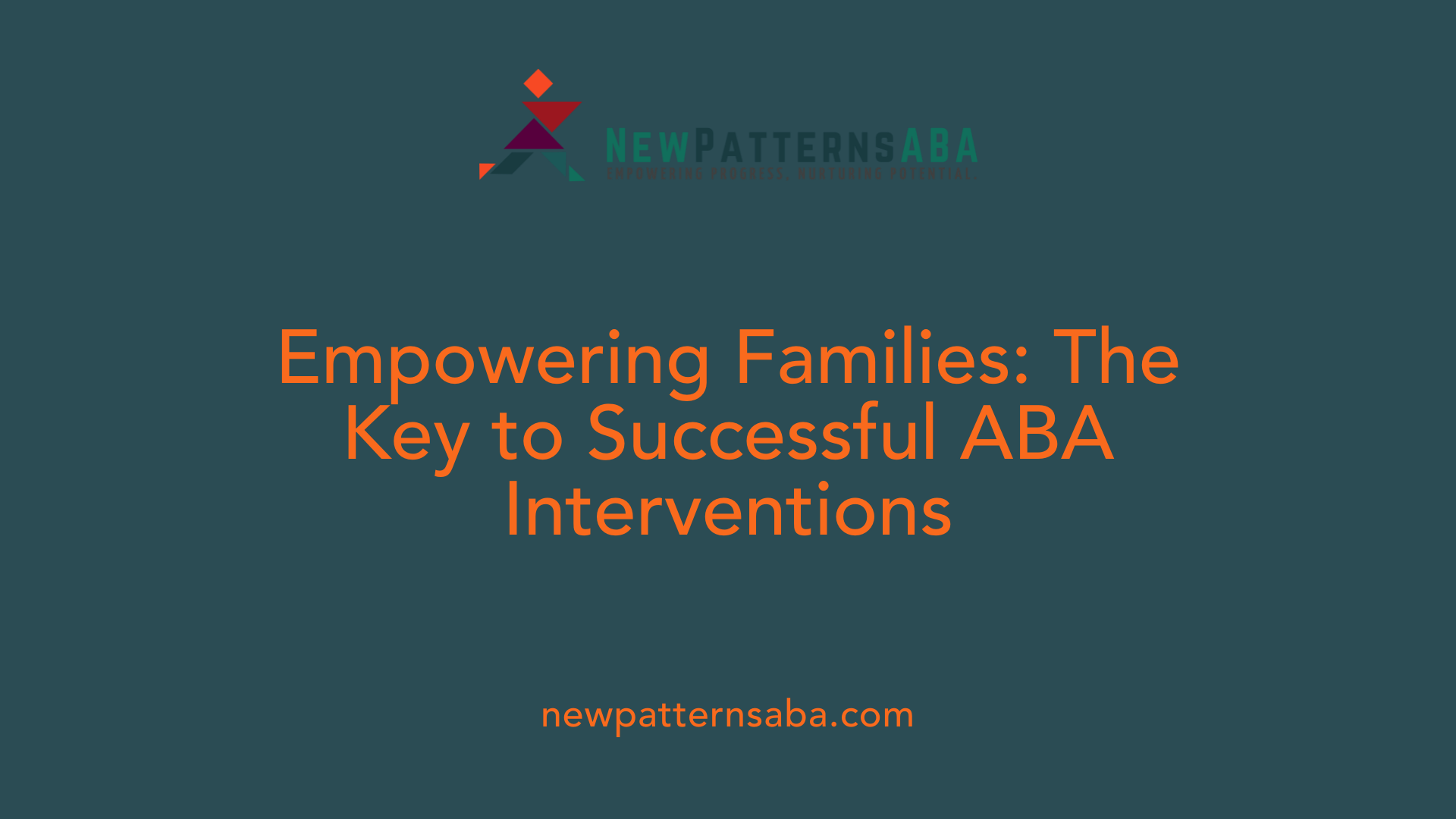Understanding the Foundation of Resilience in Autism
Building resilience in children with autism is essential for enabling them to navigate life's challenges with confidence and independence. In-home ABA therapy has emerged as a promising approach by providing personalized, consistent support within the comfort of the child's natural environment. This article explores how tailored interventions, combined with nurturing relationships and family involvement, foster emotional growth, social skills, and adaptive behaviors—ultimately empowering children to thrive.
The Principles and Personalization of In-Home ABA Therapy

How does All Together ABA develop individualized treatment plans?
All Together ABA emphasizes creating personalized therapy programs tailored to each child's unique needs. Starting with thorough assessments, clinicians observe and analyze the child's strengths, challenges, and behavioral patterns. This data-driven approach allows practitioners to set customized goals that address specific developmental areas, such as communication, social interaction, or self-care skills. The treatment plans are flexible and continuously refined based on ongoing progress monitoring, ensuring that interventions remain relevant and effective.
What role do thorough assessments and goal setting play?
Assessments form the foundation of effective ABA therapy. They help identify behavioral triggers, learning styles, and areas needing support. After these evaluations, therapists collaborate with families to establish clear, achievable objectives. Goals are often segmented into short-term milestones and long-term targets, providing parents and children with tangible progress markers. Setting realistic and specific objectives keeps therapy focused, motivating both caregivers and children to achieve incremental successes.
How is therapy customized based on the child's strengths and challenges?
Every child has a unique profile of abilities and obstacles. Recognizing this, All Together ABA crafts individualized plans that leverage each child's strengths—such as a talent for visual learning or musical memory—to facilitate skill acquisition. Simultaneously, the therapy addresses challenges, like difficulty with emotional regulation or social cues. Techniques such as visual supports, reinforcement strategies, and tailored routines are integrated to enhance learning outcomes. This personalized approach ensures that therapy is engaging, relevant, and promotes meaningful progress.
What methods are used to build resilience in children with autism through in-home ABA therapy?
Building resilience involves boosting emotional regulation, social skills, and adaptability. In-home ABA therapy uses Positive Reinforcement to encourage desirable behaviors, helping children feel more confident and motivated. Managing antecedents by creating predictable routines reduces anxiety and behavioral setbacks.
Sensory-friendly environments support stress reduction, while teaching self-regulation techniques like mindfulness and sensory tools helps children manage triggers. Moreover, fostering secure, trusting relationships with caregivers and peers promotes social connections essential for resilience. Skilled professionals such as Board Certified Behavior Analysts (BCBAs) collaborate with families to implement customized, goal-oriented programs that develop perseverance and emotional strength in a familiar setting, enhancing the child's ability to bounce back from adversities.
Family-Centered Care and Parent Training

How important is family involvement in ABA therapy?
Family involvement plays a vital role in the success of ABA therapy for children with autism. Engaging family members, especially parents and caregivers, ensures that therapeutic strategies are consistently reinforced outside of clinical sessions. This continuity helps children apply learned skills across different settings, promoting generalization and sustained progress.
When families actively participate, they gain a deeper understanding of autism and the specific behavioral goals being targeted. This knowledge empowers them to support their child's growth with confidence and patience. A family-centered approach encourages open communication and collaboration with professionals, fostering an environment where the child's needs are prioritized holistically.
Research underscores the benefits of involving families, showing improvements in social skills, communication, and emotional resilience. Families who are engaged and informed are better equipped to address challenges, celebrate achievements, and adapt strategies as their child's needs evolve.
How do education and training for caregivers support effective interventions?
Providing caregivers with education and training is fundamental to the effectiveness of ABA therapy. Through these programs, parents learn how to implement reinforcement techniques, manage behavioral challenges, and incorporate learning opportunities into daily routines.
Training sessions often include practical demonstrations, coaching, and resource sharing, which help caregivers feel more confident and capable. Visual supports, such as visual schedules and picture cards, are taught to facilitate routine understanding and reduce anxiety.
By understanding autism and behavioral principles, caregivers can better interpret their child's responses and tailor their interactions positively. This consistent approach enhances skill acquisition, encourages positive behaviors, and reduces occurrences of problematic behaviors.
How can families support at-home reinforcement and maintain consistency?
Consistency at home is crucial for the success of ABA interventions. Families are encouraged to create structured environments with designated spaces and visual supports like charts and schedules. These tools help children understand routines and expectations, reducing uncertainty and anxiety.
Reinforcement strategies, such as praise, rewards, and preferred activities, should be personalized to motivate the child. Regularly using these positive reinforcement techniques encourages desired behaviors and helps embed learned skills into daily life.
Establishing a daily routine that incorporates therapy activities, natural learning opportunities, and breaks enhances engagement. Consistent application of strategies across settings and from all caregivers maximizes learning outcomes.
Involving family members in tracking progress through data collection allows for adjustments in strategies, ensuring interventions remain effective and aligned with the child's changing needs. Regular communication with ABA professionals also helps clarify goals and troubleshoot challenges promptly.
More insights on family involvement in ABA for autism
Research shows that active family participation not only boosts immediate progress but also fosters long-term resilience. Families equipped with knowledge and skills can better advocate for their child's needs, navigate community resources, and support social inclusion.
Overall, integrating family-centered care into ABA therapy creates a supportive, adaptive environment that promotes independence, confidence, and a higher quality of life for children with autism.
Multidisciplinary Collaboration and Community Resources
The role of BCBAs, speech-language pathologists, and occupational therapists
In autism therapy centers like All Together ABA and Bright Pathways ABA, a team of diverse professionals works together to provide comprehensive support. Behavior Analysts (BCBAs) oversee the development and implementation of tailored ABA programs, ensuring each child's unique needs are addressed. Speech-language pathologists focus on improving communication skills, both verbal and non-verbal, through specialized techniques like modeling and reinforcement. Occupational therapists help children enhance daily living skills, sensory processing, and motor coordination. This collaborative approach ensures that children receive well-rounded care that promotes behavioral, communication, and functional skills.
Collaborations with community organizations
These centers actively partner with local community groups, schools, and other service providers. Such collaborations are essential for creating a network of support that extends beyond therapy sessions. By working closely with schools, providers can tailor educational plans to promote better learning and social integration. Partnerships with community organizations also facilitate access to resources like recreational programs, vocational training, and support groups, helping children and families foster independence and social engagement.
Access to support groups, recreational programs, and advocacy
Community involvement is vital for building resilience in children with autism. Support groups provide a platform for families to share experiences, seek advice, and gain emotional support. Recreational programs tailored for children with autism enhance social skills and provide fun, natural environments for learning. Additionally, advocacy services help families navigate insurance coverage, educational rights, and other essential resources. This comprehensive network encourages families to stay connected, empowered, and actively involved in their child's development.
| Aspect | Description | Additional Details |
|---|---|---|
| Professional Team | BCBAs, speech therapists, occupational therapists | Multidisciplinary for holistic care |
| Community Partnerships | Schools, local organizations | Support educational and social integration |
| Family & Support Networks | Support groups, recreational programs, advocacy services | Enhance resilience, social skills, and resource access |
Creating Structured and Predictable Environments

Use of visual supports like schedules and picture cards
Visual supports such as picture cards and visual schedules play a crucial role in helping children with autism understand daily routines and expectations. These tools reduce anxiety by providing clear, consistent cues and making abstract concepts more concrete. Children can better anticipate upcoming activities, which fosters independence and confidence.
Developing daily routines that include therapy sessions
Establishing a consistent daily routine is vital for reinforcing learned skills and maintaining stability. Incorporating scheduled ABA therapy sessions into the day ensures regular practice and reinforcement. A structured schedule that includes time for play, learning, and relaxation supports behavioral consistency and skill generalization.
The importance of consistency and familiarity
Consistency across home, therapy, and community environments fosters trust and predictability for children with autism. When routines are familiar and routines are followed diligently, children develop a sense of security, making them more receptive to learning new skills. Maintaining routine consistency also helps caregivers and therapists monitor progress and adapt strategies effectively.
| Aspect | Benefits | Additional Notes |
|---|---|---|
| Visual supports | Clarify routines, reduce anxiety | Use with schedules, charts, or picture cards |
| Structured routines | Promote skill mastery, stability | Includes therapy, play, and family activities |
| Consistency | Build trust, improve learning | Coordinate home, school, and community efforts |
Creating a structured environment supports children in becoming more independent and confident by making daily life more predictable. Using visual aids along with consistent routines ensures that children receive clear guidance and feel secure as they learn new skills.
Effective ABA Techniques to Enhance Emotional and Social Development
How does ABA therapy support emotional development, attachment, and nurturing in autistic children?
ABA therapy plays a significant role in fostering emotional growth and secure attachments among children with autism. It focuses on teaching social-emotional skills like recognizing facial expressions, understanding body language, and interpreting tone of voice. These skills are fundamental for children to form meaningful relationships.
Using methods such as role-playing, social stories, and positive reinforcement, therapists help children learn to interpret social cues and develop empathy. These approaches encourage children to engage in appropriate social interactions, which helps build trust and emotional bonds.
Group activities and peer interactions are often integrated into ABA programs, offering opportunities for children to practice social skills in real-world settings. This supports the development of friendships and helps children experience secure attachments within a supportive environment.
Addressing emotional regulation and social anxiety is also a priority. Tailored interventions assist children in managing stress and gaining confidence in social situations. Engaging with special interests and participating in community activities further enhance social connection, self-esteem, and a sense of belonging.
Overall, ABA therapy promotes not just skill development but also nurtures emotional resilience. By strengthening emotional understanding and social bonds, it helps children build nurturing relationships and develop a robust sense of self. This holistic approach is essential for their long-term emotional well-being and social integration.
How does ABA address behavioral challenges and promote social skills?
ABA's structured environment breaks down complex skills into manageable steps, making it easier for children to learn and practice desired behaviors. Techniques like positive reinforcement reward children for exhibiting prosocial behaviors such as sharing, turn-taking, and acceptable emotional responses.
Social stories and visual supports, like picture cards and schedules, help children understand routines and social expectations, reducing anxiety and promoting clear communication.
Consistent data collection and collaboration with therapists allow for ongoing adjustments to strategies, ensuring that each child's unique needs are met. Over time, children learn to regulate their emotions better, approach social situations with confidence, and develop meaningful relationships.
Important considerations in ABA therapy for emotional and social growth
| Aspect | Description | Additional Details |
|---|---|---|
| Tailored goals | Individualized to each child's strengths and challenges | Focuses on specific emotional and social milestones |
| Family involvement | Parents and caregivers receive training and support | Reinforces skills at home and in community settings |
| Structured routines | Establishing predictable schedules | Eases anxiety and promotes skill generalization |
| Reinforcement strategies | Personalized to child's preferences | Encourages positive behaviors and emotional regulation |
ABA strategies are integral to helping children with autism develop emotional resilience and social competence, ultimately supporting their ability to engage meaningfully with others and thrive in various environments.
Building Resilience through Comprehensive Developmental Support

How can understanding developmental aspects help in enhancing resilience in children with autism?
Understanding the developmental characteristics of children with autism is fundamental to fostering their resilience. Autism is a spectrum, and each child experiences unique challenges and strengths. By recognizing these individual differences, caregivers and professionals can tailor their support strategies to meet specific emotional, social, and behavioral needs.
A key element is building and maintaining secure attachment relationships. When children feel safe and supported through consistent, nurturing interactions, they develop a sense of relational safety. This sense of security provides a solid foundation for facing and managing stressors, thereby promoting organic resilience rather than superficial coping mechanisms like masking or emotional suppression.
Supporting development involves providing appropriate scaffolding—gradually guiding children through tasks and social interactions while respecting their boundaries. Recognizing each child’s individual pace and strengths empowers them to expand their capabilities confidently. Incorporating emotional regulation techniques, such as teaching children how to identify and express their feelings, enhances their ability to adapt to challenges.
Creating predictable routines and a stable environment also plays a vital role. When children know what to expect, their anxiety decreases, enabling better emotional processing and resilience. Additionally, fostering positive relationships within family and community settings, including support from peers and professionals, reinforces their capacity to handle adversity.
Ultimately, emphasizing relational safety, respecting developmental trajectories, and providing personalized support help children with autism develop robust resilience. This resilience allows them to navigate life’s challenges with confidence, fostering healthy growth and independence.
Integrating Resilience Building within ABA in a Home Setting

How can resilience-building approaches be integrated with ABA therapy in a home environment for children with autism?
Integrating resilience skills into ABA therapy at home involves embedding strategies that promote emotional resilience, problem-solving, and adaptive coping alongside behavioral goals. Therapists and caregivers work together to incorporate practical activities such as role-playing, guided imagery, and creative arts, which help children develop emotional regulation and social skills.
Family participation plays a vital role in creating a supportive environment. Regular family involvement through training and family therapy sessions can reinforce resilience techniques, strengthen family bonds, and boost the child’s confidence.
It's also important to customize interventions to accommodate cultural perspectives and environmental factors, including social acceptance and community resources. This personalized approach ensures that resilience-building is not an isolated activity but part of a holistic, ongoing effort.
Ongoing evaluation and collaboration with community programs including support groups, recreational activities, and vocational training are essential. These steps help integrate resilience practices into daily routines, making them a natural part of the child's growth and development.
In summary, combining ABA strategies with resilience-building activities at home effectively supports children with autism in overcoming challenges, fostering emotional strength, and developing lifelong skills.
Long-Term Benefits and Ongoing Support
How does ABA therapy contribute to improved independence and social skills?
ABA therapy is designed to help children with autism develop essential life skills. It breaks down complex behaviors into manageable steps, using positive reinforcement to encourage progress. Through personalized treatment plans, children work on improving communication, such as initiating conversations or understanding social cues. They also learn practical skills like self-care and daily living activities. Over time, these skills lead to greater independence, enabling children to perform tasks with less assistance.
What impact does ABA have on a child’s overall quality of life?
Beyond skill development, ABA therapy enhances a child's overall quality of life by reducing behavioral challenges and increasing positive interactions. As children gain better communication and social skills, they can engage more meaningfully with family, friends, and their community. This improved engagement fosters happiness, reduces frustration, and promotes a sense of achievement. Additionally, early and consistent intervention can lead to better long-term outcomes, giving children more opportunities for success in various settings.
Why is continued family and community involvement important?
Family involvement remains central to the success of ABA therapy. Caregivers are often trained to reinforce strategies at home, creating a consistent environment that supports progress. Community resources, such as support groups, recreational programs, and vocational training, further bolster development and inclusion. Collaborative efforts with schools and service providers ensure children receive comprehensive support, helping them adapt to different environments and build resilience.
| Aspect | Benefits | Additional Details |
|---|---|---|
| Independence | Greater self-sufficiency | Skills like dressing, feeding, and safety awareness |
| Social skills | Improved interactions | Sharing, turn-taking, understanding social cues |
| Quality of life | Increased happiness and engagement | Reduced frustration, better communication |
| Family involvement | Consistent reinforcement | Education, training, and active participation |
| Community engagement | Broader opportunities | Support groups, recreational and vocational programs |
Understanding and supporting these long-term benefits help ensure children with autism can thrive and reach their full potential.
Conclusion: Cultivating a Resilient Future for Children with Autism
In summary, supporting children with autism requires a comprehensive, personalized approach that emphasizes the importance of early, in-home ABA therapy. This science-based intervention adapts to each child's unique needs, fostering vital skills such as communication, social interaction, and self-care. The development of tailored treatment plans, based on thorough assessments, ensures that therapy targets specific behaviors and milestones, maximizing progress.
Consistency is crucial, with regular sessions and structured environments that include visual supports like schedules and charts. Reinforcement techniques—both positive and negative—encourage desired behaviors, while tracking progress through data collection allows therapists and families to refine strategies effectively. Collaboration among multidisciplinary teams and active family involvement further boosts outcomes, helping kids generalize skills across settings and routines.
Building resilience in children with autism also involves supporting their families. Parental self-care, establishing support networks, and maintaining open communication with healthcare providers help parents manage stress and foster a positive environment at home. Practicing patience and celebrating small victories motivate ongoing progress and reinforce a hopeful outlook.
For practitioners, providing compassionate, individualized care while continuously collaborating with families ensures sustainable growth for their young clients. The collective effort of tailored therapy, family engagement, and community resources creates a nurturing environment that promotes independence, confidence, and long-term success.
Ultimately, fostering resilience in children with autism not only enhances their current quality of life but also paves the way for a more inclusive, supportive future. By embracing personalized strategies and unwavering collaboration, families and professionals can make a meaningful difference in the lives of children navigating autism.
Fostering Resilience for a Brighter Future
Building resilience in children with autism through in-home ABA therapy is a multifaceted process that requires personalized interventions, family involvement, and a nurturing environment. When tailored strategies are combined with secure attachments and ongoing support, children develop the skills necessary to navigate challenges, build confidence, and achieve independence. Collaboration among professionals, families, and community resources amplifies these efforts, creating a comprehensive support system. As families and practitioners prioritize emotional growth, social connection, and resilience, they lay the foundation for a future where children with autism can reach their full potential and lead meaningful, autonomous lives.
References
- Building Resilience and Support for Autism Challenges
- How to Build Resilience as a Parent of an Autistic Child
- How to Effectively Do ABA Therapy at Home for Your Child - Ruby ABA
- ABA Therapy: Building a Strong Foundation for Growth
- Applied Behavior Analysis (ABA) | Autism Speaks
- How To Deal With Meltdowns: ABA Strategies For Success
- 5 Ways Autism Strengths Resilience - Overcoming Bullying with ...
- How ABA Therapy Enhances Social Skills in Children with ASD





